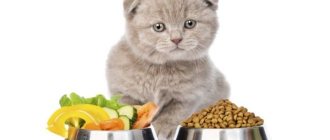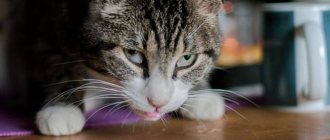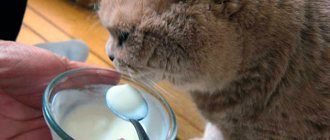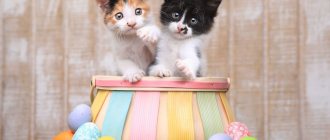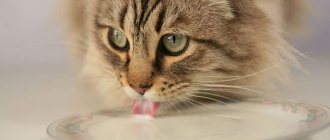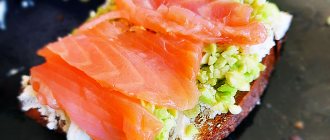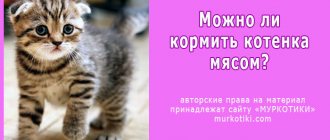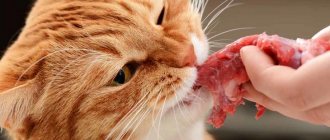After reading the material, you will find out whether it is possible to feed milk to kittens and adult cats, about the dangers and benefits of milk for the cat’s body. In the article, we talked about the types of milk in a kitten’s diet and how you can feed a kitten left without a mother. We also figured out how to identify lactose intolerance in animals.
The classic image of kittens lapping milk from a bowl is familiar to many from childhood. Therefore, many owners often give it to kittens first. However, it is important to understand that this is not necessary and milk for kittens can be a source of problems.
Small and adult cats love milk very much
Nutritional features of kittens
For the first two months of their lives, kittens get everything they need from cat's milk. At this age, they digest their mother’s milk well thanks to the enzyme lactase. This enzyme is necessary to break down the lactose contained in milk. With age, the production of lactase in the pet’s body decreases, but the animal’s appetite for milk may remain.
Month-old kittens gradually begin to switch to solid food, trying to eat meat products little by little with the cat. At the same time, they do not stop feeding on their mother’s milk. In the kitten’s body, preparation for adult life begins: the production of lactase is gradually reduced to a minimum, and other enzymes are produced for digestion, which are involved in the breakdown of protein foods.
The kitten's body absorbs mother cat's milk well
By 2 months of age, the cat begins to wean the kittens from breastfeeding, and they begin to feed on their own. At this time, lactase usually stops being produced.
For cubs, milk is the main food, but for adult cats it is contraindicated due to the fact that the gastrointestinal tract does not digest it, which can cause bloating, pain and diarrhea. There are rare cases where lactase continues to be produced in the body of an adult cat.
Adult cats produce almost no lactase
Menu made from natural ingredients
Supporters of “natural food” emphasize its naturalness and safety for the cat’s body. Despite this statement, natural products have their drawbacks: not all of them are equally healthy and harmless.
Advantages and disadvantages
The main advantage is the ability to independently select ingredients. This eliminates the presence of artificial colors and preservatives. Also among the advantages it is worth noting:
- menu variety;
- the ability to replace one dish with another without harm to the body;
- absence of dependence and addiction.
The disadvantages of “natural” food lie in the difficulty of regularly preparing fresh dishes and complying with the recommended consumption of vitamin and mineral complexes. Such food requires a lot of free time and is sometimes more expensive than dry food.
Required Products
The diet is based on meat, offal, dairy products, cereals and vegetables. Due to the danger of infection by parasites, offal is given only in boiled form twice a week. I also boil chicken breast, turkey, veal or other lean meats, and 60% of the diet should come from protein products.
Once a week, the meat is replaced with sea fish, cleaned of bones. It is enriched with phosphorus, which improves wool quality. Eating fish too often can lead to loss of vitamin K and the development of urolithiasis due to excess protein.
Prepare healthy dishes based on grated zucchini, beets, carrots and herbs, adding small pieces of meat to them. Offer 1 teaspoon three to four times a week. vegetable oil from olive or flax. Once a week, add the boiled yolk of a chicken or quail egg to the porridge - it normalizes digestion.
Natural cottage cheese and low-fat sour cream are available sources of calcium. They strengthen bones and saturate the body with vitamins.
Prohibited Products
Another disadvantage of “natural” is the presence of prohibited products. These include:
- bones that can damage the esophagus or block the supply of oxygen;
- fatty meat and lard that overload the liver;
- mushrooms, eggplants, garlic, legumes, potatoes, tomatoes and onions;
- any seasonings;
- raw egg whites and chicken skin;
- whole milk, which causes digestive problems due to lactose intolerance;
- canned, smoked, fried or other dishes from the human table;
- sweets and baked goods considered toxic to animals;
- river fish containing the most dangerous parasites.
Lactose problems are more common in older animals, but sometimes occur earlier. Observe the kitten after he has treated himself to milk.
Milk for kittens - benefits and harm
Milk is undoubtedly a product rich in beneficial components. These are fatty acids, animal proteins and various microelements. They are sources of energy, and most of the components in its composition are building materials for new cells.
Milk has many benefits, but it can also have a negative impact on a kitten's health. Disadvantages of eating milk:
- indigestion;
- imbalance of proteins, fats and carbohydrates;
- the danger of sand and stones forming in the cat’s bladder;
- risk of developing an allergic reaction to milk.
Many veterinarians agree that milk is completely useless for adult cats, since its components are practically not absorbed by their bodies.
Milk contains many useful substances, but it can be dangerous for a kitten
Prohibited foods for the diet
It is recommended to exclude the following products from the kitten’s menu:
- milk and fatty dairy products;
- fried and salted foods;
- smoked meats and sausages;
- pork;
- River fish;
- potatoes, tomatoes, grapes, citruses, pineapple, kiwi;
- chocolate and bakery products;
- bones of animals, birds or fish;
- food from a person's table;
- dog food.
To prevent your kitten from eating prohibited foods, you need to follow these simple tips:
- Do not allow the kitten to sit on the table while preparing or eating food.
- Don't feed table scraps.
- During the holidays, be on your guard - scents can tempt even the most well-mannered and obedient animal.
- Keep food out of the kitten's reach. If he shows interest, install special locks on the cabinet doors.
Don't let the kitten sit on the table
Prolonged feeding of a kitten with human food leads to metabolic disorders, diseases of the gastrointestinal tract, heart and blood vessels.
Poor quality of the finished food or intolerance to a certain type can cause digestive problems in the kitten. In this case, you should consult a veterinarian and choose a different type of food or a different type and brand of food; it is better to give preference to products with a higher price. Saving on the animal's nutrition will negatively affect its health and will lead to even greater costs for the treatment of diseases that arise as a result of eating low-quality food.
Lactose intolerance in kittens - signs
Lactose or milk sugar is found only in milk.
Symptoms of lactose intolerance become apparent approximately 8-12 hours after the kitten drinks the milk. Intolerance manifests itself in the form of diarrhea, vomiting and bloating.
This happens due to the inability of the kitten’s body to process lactose, which passes through the intestines unchanged. By attracting water, it moves further and in the large intestine it meets bacteria that try to process it. This is accompanied by the release of hydrogen, carbon dioxide and a number of other substances, causing fermentation in the kitten’s body.
Lactose is found only in milk
Scientists' opinion
Experts spent a long time figuring out whether cats can be given cow's milk or not. In their opinion, its use by any adult animal is unnatural, since in nature only young animals feed on it.
The young body secretes a large number of enzymes designed to digest lactose. It is lactose that a newborn baby absorbs with mother's milk. As an animal grows, the number of special enzymes in its body decreases. Therefore, a growing animal must be gradually fed with food for adult animals.
But why then do cats and kittens in some cases eat a product intended for babies? The body of an adult animal still produces a certain amount of enzymes capable of digesting milk. Therefore, adult cats and cats can drink milk.
However, the volume of dairy products that is absorbed in their body depends only on individual characteristics. Therefore, it is still not recommended to feed adult animals cow's milk. Moreover, with age, it is absorbed in the body worse and worse.
A somewhat difficult situation arises with newborn fur babies who are not fed by their mother. Is it possible to give kittens milk?
Is it possible to give cow's milk to a kitten?
Cow's milk contains many vitamins and nutrients. It contains elements such as iodine, calcium, magnesium, selenium and others. These components are important for a kitten, but we must not forget that the composition of such milk is very different from cat milk. It is not as nutritious and does not contain the amount of nutrients needed for normal development. But this milk also contains elements that are either simply not needed by the pet or can be harmful to health.
Cow's milk is a difficult product for kittens. It can cause an allergic reaction and diarrhea. If the cow was fed industrial feed that contained pesticides, then consuming milk from such a cow can cause poisoning. A pregnant cow produces milk with a high content of the hormone estrogen, which can lead to hormonal imbalance in the kitten, and subsequently to serious illnesses. Sterilized milk from the store is a useless product for an animal, from a nutritional point of view.
Cow's milk can cause allergies in kittens
You can try giving your pet lactose-free milk. It is harmless to the kitten. However, there is no practical benefit from this type of milk.
What to feed a 1.5 month old kitten
At 1.5 months, the kitten can already eat on its own. The weight of the animal can range from 500 to 700 grams. At this time, the kitten needs a complete diet. If the baby is fed natural food, the owner should take care of the variety of food. At one and a half months of age, kittens can be fed the same foods as at four weeks, but gradually new foods can be included in the kitten’s diet:
- porridge from buckwheat, rolled oats (without salt and sugar);
- boiled vegetables (cabbage, carrots, broccoli, zucchini, etc.);
- raw meat (veal, lamb, turkey, chicken, etc.);
- offal, raw or boiled (chicken liver, heart, lungs);
- cottage cheese (fat content no more than 9%) 30 g per day;
- raw fish, scalded with boiling water (without bones, scales, etc.) once a week;
- specially grown greens (you can grow it yourself or buy it at a pet store).
When my cat was little, I fed him oatmeal mixed with wet kitten food, or just boiled meat, or chicken, or fish. Once a week it is recommended to give cats liver and eggs. I bought vitamins from DoctorZOO for kittens. He also very often received leftover baby purees (vegetables and meat), cottage cheese, etc.
Tigrasha, forum user
https://forum.say7.info/topic1753.html
The kitten's menu should expand every month
Feeding frequency
A one and a half month old kitten can be fed 5-6 times a day. The daily amount of food should be about 120 grams per day. Some kittens do not eat all the food offered at one time; this cannot be ignored. It may be difficult for the animal to switch to infrequent feedings. This way he will remain half-starved. If you begin to feed the kitten less often, then the portions should be larger.
Your pet may eat less than 120 grams per day, this may be due to the fact that he does not like the food. There is still a possibility that the baby is sick. Consult your veterinarian; frequent refusals to eat indicate poor appetite.
Closer to 2 months, the volume of the daily diet can be increased to 160–180 grams. But here it all depends on the kitten itself. There are more active kids who constantly play and frolic. Such kittens will eat more than their calm brothers.
It is also important what time of day you feed your pet. There are people who go to work in the morning and come late in the evening. This does not mean that you need to feed the baby in the morning and postpone the next meal until the evening. During one dinner, a kitten will not be able to eat all the food allotted to it at once, and saving part of dinner for a night meal threatens to overeat. In such cases, you can feed the kitten in the morning, leave some of the food in a bowl (it will be eaten closer to lunch), and feed it dinner in the evening. In addition, you can ask your neighbors to come in and feed the cat after lunch.
You need to make sure that the kitten does not remain hungry or overeat
Vitamins and supplements
Natural feeding of small kittens may require vitamins. There are vitamin supplements that are designed for kittens from one and a half months of age:
- "Doctor Zoo";
- "Farmavit";
- Kitzim;
- "Biofar";
- "Brevers", etc.
The owner of a kitten should not run to the veterinary pharmacy and immediately buy all the supplements that will be offered to him. First, it is advisable to consult a veterinarian. Specialists are better versed in the world of veterinary drugs. Perhaps your cat already has enough vitamins, but consuming them in excess can lead to hypervitaminosis. And secondly, you need to carefully study the instructions for the vitamin supplement. Some cat breeders make the mistake of buying 2 different supplements with a similar composition. If you decide to purchase at least 2 drugs, then you need to make sure that their components are not repeated.
In general, the instructions for use describe in detail the indications and contraindications for use. The packaging also indicates why certain vitamins are needed. The most common vitamin supplement given to kittens is fish oil. Breeders recommend giving it to animals 2 capsules per week. If fish oil is purchased in capsules, the liquid can be added to food by piercing the capsule shell with a needle.
In pet stores you can buy special treats for kittens with vitamin supplements.
The mistake is made by those cat breeders who try to saturate the animal’s body with vitamins from individual products. For example, I know a family who feed small kittens (up to 2 months) fresh sprat. Allegedly, this fish contains phosphorus, which is so beneficial for animals. In fact, excess phosphorus leads to the deposition of kidney stones. It is precisely because of the risk of developing urolithiasis that cats and kittens are not recommended to abuse fish at all. In addition, a veterinarian I know told me that fish contains an enzyme that can decompose vitamin B1 (thiamine).
What a kitten shouldn't eat
There are some foods that should not be fed to kittens of any age:
- ready-made food from the table (it may contain salt, spices, etc.);
- medicines and vitamin preparations for people;
- sweets (accumulates in the blood);
- pork and lamb (meat is too fatty and can also be infected with parasites);
- river fish (lots of bones, there is a risk of infection with parasites);
- bones (the kitten can seriously damage the esophagus or stomach);
- legumes (not digested);
- potatoes (not digested, causing fermentation, and also have too much starch);
- fatty fermented milk products (including cheese);
- flour.
The danger is that small kittens can beg for a long time and persistently. It can be very difficult to resist such pressure. For example, when my cat was little, she skillfully begged for ice cream. Of course, you can’t pamper kittens with such “goodies” - they’re too fatty and sweet. In addition, various artificial ingredients are now added to ice cream.
Loving owners sometimes spoil their kittens with ice cream, but this is very dangerous.
Are sheep and goats allowed?
Goat's milk is easier to digest and is absorbed very quickly by the kitten's body. It should also be noted that it contains vitamins A, B1 and B2. The proteins contained in such milk are much less likely to cause intolerance in kittens. Goat's milk is better in composition than cow's milk. In addition, it is low-allergenic. Sheep milk is very similar in properties to goat milk.
Don't forget that store-bought cow's milk usually has reduced fat content, while goat's or sheep's milk is most often sold with natural fat content.
Thus, the question of whether it is possible to give a kitten goat’s milk can be answered positively, but it is advisable to dilute it with a small amount of water.
Goat's milk is much healthier for a kitten than cow's milk
Fermented milk products
In case of a negative reaction of the body of furry pets to drinking milk in its pure form (diarrhea, flatulence), it is replaced with fermented milk products. They are absorbed much better and faster, improve gastric secretion, normalize intestinal motility, and reduce gas formation.
What cereals can be given to cats - healthy and forbidden cereals in the diet
All fermented milk can be divided into two groups: those obtained by lactic acid fermentation, those produced by mixed fermentation.
Produced by lactic acid fermentation
This group includes: cottage cheese, sour cream, yogurt, yoghurt, fermented baked milk of various types, bifidok. You can treat your cat with them right away, of course, if the expiration date is met.
Important! It is contraindicated to feed cats sweetened yoghurts with fillings and curd cheeses.
With mixed fermentation
Mixed lactic acid and alcohol fermentation produces kefir (biokefir) and kumis. Before feeding your tailed kefir, you need to look at the date of its manufacture: the older it is, the stronger it is and the higher the proportion of carbon dioxide in it. Freshly made kefir contains no more than 0.2% ethanol, the alcohol content in old kefir (which is more than three days old) does not exceed 0.6% (subject to storage temperature).
Note! Young kefir has a laxative effect, while ripe kefir, on the contrary, strengthens. If an animal has difficulty defecating, it can only be given fresh kefir; if it has diarrhea, it can be given mature kefir. In any case, biokefir containing probiotics is suitable for your pet, as they stabilize the intestinal microflora, making constipation and diarrhea a thing of the past.
Fat content of fermented milk products
Representatives of the cat family are fed fermented milk products of a certain percentage of fat content. Too fatty food can lead to stomach upset; low-fat food will be useless for the cat’s body.
The best option would be food with the following percentage of fat content:
- cottage cheese - no more than 9%;
- curdled milk, yogurt, kefir (biokefir), fermented baked milk - up to 4%;
- sour cream - up to 10%, and it must be diluted with warm water in a percentage ratio of 1:1.
All cheeses are generally too fatty, so feeding them to cats is not recommended. The exception is unsalted cheese varieties, for example, Adyghe, but it is advisable to give it rarely and in small portions. Under no circumstances should you give condensed milk; this always risks causing diarrhea in the animal. Baked milk has a fat content of 4-7%, so it is not recommended to be given to cats prone to obesity.
It should be remembered that each organism is individual. The same product can cause completely different reactions. It happens that a fermented milk product with a small percentage of fat content provokes diarrhea. At the same time, you should not replace it with low-fat one; it must be excluded from the diet.
Is plant milk suitable for a kitten?
Owners of kittens who support a vegetarian diet are wondering whether their kittens can be given plant-based milks.
Almond milk is made from a mixture of ground, unroasted almonds and water. There is no lactose in this milk. But almonds are toxic to cats.
Soy milk also does not contain lactose. But soy is very difficult for the delicate cat’s body to digest, since the kitten’s body does not have enzymes to process it. Even if your pet drinks soy milk, there will be no benefit from it.
Coconut milk is obtained by squeezing coconut pulp. Due to the high fat content of coconut milk, it is not only not healthy for the kitten, but in large quantities it is very harmful and leads to excess weight gain.
Cats are carnivores by nature, which makes it difficult for them to absorb plant-based substances. Therefore, you should not experiment with your pet’s nutrition. All a kitten needs is ordinary clean water. It is needed for the development of the cat’s body and promotes better absorption of food.
Kittens do not digest plant milk well
Dry and wet food
In addition to classic dry food, you can use wet canned food. Together they compensate for each other's shortcomings: 75% of the diet is allocated to dry food, and 25% to wet food. This also has its own nuances, so before deciding what food to feed a 2-month-old kitten, compare the advantages and disadvantages of each method.
Advantages and disadvantages
Most of the disadvantages lie in low-quality economy class products. It is prepared from low-quality raw materials (bones, fats, skins, feathers) with an abundance of mineral salts, preservatives and flavorings. These ingredients have a detrimental effect on the cat’s body, provoking the development of urolithiasis.
If an allergy or other disease occurs that requires a change in food, it takes quite a long time (8-10 days) to mix new granules with the old ones in order to make a smooth transition. Abrupt transitions are excluded, as they can provoke gastrointestinal upset.
Safe and healthy products include premium, super-premium and holistic classes. Their advantages are:
- an abundance of different lines developed for individual breeds, as well as taking into account age characteristics and the presence of diseases;
- saving time on cooking;
- availability of daily allowances on each package;
- balance of composition;
- prevention of tartar and strengthening of the jaw muscles.
Dry granules take up little space, making them easier to take when traveling. It is easier to leave an animal with this type of food for foster care with relatives or friends. Even an elderly person with limited mobility can feed your pet.
Variety of food for kittens
When purchasing a furry family member through a breeder, check in advance what to feed your two-month-old baby. If the seller has already started feeding him a specific brand, then stick to the same brand for up to a year.
The most expensive granules and wet canned food belong to the holistic class. Despite their prestige, they are not suitable for animals with problems with the urinary system.
The best brands of kibble and canned food that have a line for kittens include:
- Hill's;
- Orijen;
- Happy Cat Junior;
- 1st Choice;
- Eukanuba;
- Royal Canin;
- ProNature;
- Purina ProPlan;
- Acana;
- Go Natural.
Wet canned food is served to your pet only when heated. Be sure to put any uneaten pieces in the refrigerator until the next feeding.
How to choose?
Avoid stores that sell pellets by weight. Once the package is opened, the shelf life is reduced. The quality of such a product is often questionable.
When choosing a brand, consider the manufacturer. Products from Russian factories are significantly inferior in quality. The safest producing country is Canada. Some Canadian food can even be eaten by humans.
Be sure to consult your veterinarian before purchasing. If there are diseases, he will offer a veterinary line.
Remember that you cannot save on ready-made food; eating budget brands will lead to the same problems as eating fast food.
Feeding kittens with milk - breed characteristics
Any milk is strictly not recommended for kittens of fold breeds. This is due to their weak immunity, and can lead to lethargy, weakness and various types of diseases. However, cats of this breed can be given kefir or cottage cheese.
There is a myth that in kittens of lop-eared breeds, milk can make their ears stand up. This is argued by the fact that milk contains a lot of calcium, which strengthens cartilage. It actually has nothing to do with milk. This phenomenon sometimes happens in some kittens, manifesting itself with age, and is a defect of these breeds.
Fold-eared kittens are not recommended to drink milk
Features of complementary feeding of individual breeds
When introducing complementary foods and preparing a diet, you need to take into account the characteristics of cat breeds. For most species, standard rules apply. But there are breeds that have certain characteristics that require correction in the complementary feeding regime.
Ragdoll kittens have a genetic disease: hypertrophic cardiomyopathy (thickening of one of the walls of the heart ventricle) and joint dysplasia. Therefore, the list of prohibited products additionally includes: meat of geese and ducks, cream, and fatty sour cream. Their consumption negatively affects cardiac activity and disrupts metabolism.
Little ragdolls
Sphynx kittens (like other representatives of hairless breeds) have a high risk of developing cardiovascular diseases. They can only be given dietary meat: turkey or chicken, rabbit, beef. Pork should not be given to any cats, and especially not to sphinxes. To start feeding, raw or boiled veal is suitable.
A Sphynx kitten needs to be fed more often than a regular cat. Six to eight meals are recommended up to two months, four meals up to five months. At the age of six months, reduce the frequency of feedings to three times a day, and from the age of nine months, accustom them to two meals a day.
Sphynx kittens
Maine Coons mature late. Cats usually feed their babies for up to two months. These kittens do not need to be fed complementary foods until they are 8 weeks old.
Maine Coon kittens differ from all others in their large size. Accordingly, more food is needed. At the age of two months, kittens should receive 130 grams of meat, up to 40 grams of vegetables and dairy products, and about 15 grams of cereal. For other breeds, this is the norm for an adult cat.
Maine Coon kittens are larger than kittens of other breeds
How to feed a kitten
Under normal conditions, the kitten is fed exclusively by the cat from birth to 1 month. At this time, the kittens feed only on her milk.
However, in some cases (a cat’s refusal to give up her kittens, the death of a cat during childbirth, lack of milk), it may be necessary to artificially feed a kitten from the first hours of life. You should immediately decide what and how many times a day to feed the kitten and strictly adhere to the schedule. The further development and health of the pet depends on the proper organization of the nutrition process.
The best option is to purchase a cat milk substitute; if this is not possible, then you need to prepare the food yourself.
Before feeding kittens, it is recommended to consult a veterinarian for assistance with food selection and additional nutrients. The doctor will also tell you how many times a day to feed the kitten and how to do it correctly.
When preparing formulas yourself, you need to take into account that the composition of cow's milk is very different from cat's milk. It contains much less nutrients and is poorly absorbed by the kitten’s body. Goat's milk is much healthier for the baby; the use of milk formulas for infants is also allowed.
Newborn kittens need mother's milk
What and how often to feed a one-month-old kitten
The main nutritional element for a small kitten is cat's milk. Regardless of whether the baby is left without the support of the mother or she is feeding her baby, babies up to a month old can be taught to feed themselves. There is no need to be afraid of this, because sooner or later the cat will still switch to another food. But it’s better to let this happen under your control.
You can start feeding kittens using a bottle and pacifier.
The baby's diet should be complete (nutritious and healthy). The food should be liquid or semi-liquid (similar to regular milk). At 1 month, a kitten can eat “baby” foods:
- Goat's milk (must be diluted with boiled water in a 1:1 ratio).
- Special dry formulas for feeding kittens (can be purchased at a pet pharmacy).
- Low-fat fermented milk products without sugar.
- Liquid porridge made from semolina or rice (the rice must first be crushed).
- Boiled egg yolk (can be mixed with low-fat cottage cheese, but this puree should be fed no more than 2 times a week).
- Simple soups (boiled lean meat + broth without salt, once a week).
- Baby meat or fish puree.
- Boiled lean meat (except pork) in small quantities (must be chopped before feeding).
- Boiled sea fish without salt (boiled fillet must be carefully cleaned of bones and chopped, can be given no more than 2 times a week).
However, 30 days after birth, you should not give your kitten all the approved foods at once. Every day you need to offer one thing. Firstly, this way you can control how the baby reacted to the new food. And secondly, the cat must gradually get used to the change in food. Too sudden changes in a child's diet can lead to serious consequences (allergies, indigestion, diarrhea, vomiting, death, etc.).
When I introduce kittens to a new food, I first let the little ones try it with my finger. If kittens lick your finger, it means they like it. Sometimes these kids turn away and resist, then I resort to cunning. I smear a small amount of food on the kitten’s nose, he has to lick it (so he’ll definitely taste it). You also need to keep an eye on the kittens while eating; the smallest animals can slip and fall into the bowl. By the way, this is why kittens are given complementary foods at the very bottom of the bowl.
Photo gallery: approved products for one-month-old kittens
Goat milk can only be given diluted
Baby food in the form of purees is inexpensive, easy to find, and kittens eat it with pleasure.
Porridge for kittens should be liquid (almost like milk)
Meat can be given separately or in broth
If a kitten is left without cat milk, then it can get most of the nutrients from fermented milk products
I fed mine with Tema (classic) children's cottage cheese, without any additives like banana. Small kittens drink little water, so you need cream with 10% fat content (the approximate fat content of mother's milk), milk is not allowed. Moreover, they ate sour cream at the level of sour cream better. I set it in the morning and it stayed for the whole day. All Agusha's canned children's meats were suitable. Only after 2 months she began to accustom her to soaked dry food for Hills kittens.
Lucia, forum user
https://forum.academ.info/index.php?showtopic=221934
There should also be a bowl of clean water next to the food. Even if it seems to you that the kitten does not drink from it, the water still needs to be changed every day. After eating, dishes must be washed and dried thoroughly. It is important that the dishes are not plastic, because pathogenic microbes can settle in scratches on plastic walls.
Up to a month, kittens need to be fed up to 8 times a day. If you have a month-old baby, feed him 7-8 times, gradually reducing the number of feedings to 6 times a day. Usually such small kittens eat every 4 hours (it is necessary so that the kitten does not have time to get hungry). A warning sign may be a baby's refusal to eat. Of course, the issue may be that the food offered is unattractive, but if the kitten turns away from food several times in a row, then this is a reason to consult a veterinarian. In young animals, diseases progress faster than in adults, so every hour counts.
Starting from four weeks of age, the kitten should be given approximately 50 milliliters of food per 100 grams of weight at a time. Average kittens do not grow more than 200 grams per month, so the approximate volume of a single serving is 100 grams. But you can’t prepare baby food for more than 24 hours - saving time will have a bad effect on the baby’s health.
Should milk and milk substitutes be given?
One-month-old kittens should not be fed only cow's milk.
Every inexperienced kitten owner wonders whether it is possible to replace cat's milk with cow's milk. In fact, cow's milk is not the best nutritional option. The fact is that it contains a lot of lactose (milk sugar). This component causes something like an allergy in felines. Small kittens (up to 4 months) easily tolerate lactose, but it is not recommended to abuse it. You can purchase an alternative to cow's milk - a special substitute. This is a powder for dissolution, it can be bought at any pet store (pet pharmacy).
If you decide to feed your kitten milk or a milk substitute, you need to remember that milk cannot become the main product of the diet. After a month, it can be given to the kitten only 2 times a day. If the kitten came to you already accustomed to milk, then the lactose-containing product can be given in the form of porridge, gradually reducing the amount of milk and increasing the content of cereals and water.
There is a superstition among some breeders: if you feed a fold-eared kitten with cow's milk, its ears will “stand up.” This is supposedly due to the fact that the ears straighten when there is an excess amount of calcium in the body. In fact, all kittens need calcium, regardless of their breed. And drooping ears rise as they grow, but milk has no effect on this. It’s just that sometimes in the fold-eared breed babies are born with “defects”.
Contrary to stories, milk does not affect the shape of the ears of Scottish kittens
If you still want your kitten to eat dairy products, then offer your pet “sour milk”. Low-fat sour cream, fermented baked milk, Varenets - there are many useful and nutritious ingredients here. As a rule, cats like these products. You can also give cheeses in small quantities (the main thing is that they are unsalted). My cat, for example, loves soft cheeses (although I give it a little at a time - two or three cubes 1x1 cm).
How to accustom your pet to solid food
You need to gradually introduce yourself to solid food. But it all depends on what kind of food you choose. For example, if a kitten is fed porridge, then at first it should be a very liquid porridge, and gradually the volume of liquid is reduced by adding more cereal. If you offer your kitten meat, then first add a little boiled and chopped fillet, for example, chicken, to the broth. Gradually the amount of meat can be increased. Some people add boiled meat to porridge. The kitten will quickly taste the taste of the dish.
Cat breeders usually have no problems with porridges and soups. It is more difficult to teach a kitten to eat dishes with pieces of vegetables or meat. Of course, a baby who has been fed cat's milk will not be able to eat solid food from the first day. You will have to spend some time with the kittens while they are learning. The smaller the solid pieces of food, the easier it will be for the animal to start eating. If your pet eats only liquids and leaves pieces of meat in the plate, then try grinding them in a blender at least once. Next time the cat will specifically look for meat even in a bowl of porridge (the instincts of a small predator will make themselves felt).
You need to gradually introduce your kitten to solid food.
What foods should your pet try first?
Of course, you cannot give your kitten raw meat from the first days. The first feeding should be gentle. Many kitten owners start feeding their little pets eggs. It can be raw or boiled yolk. The raw yolk is mixed with milk or a milk substitute. A hard-boiled yolk can also be mixed with milk, but more often it is softened with vegetable oil (1 g). This is necessary to prevent the kitten from choking on the dry product.
Some owners use corn oil (1 teaspoon). Add butter and half the boiled yolk to 50 ml of milk. You should not give your kitten this kind of food all the time. After the first feeding, pay attention to the behavior and condition of the animal. An attentive owner will immediately notice if such food is not suitable for the kitten (vomiting or diarrhea may occur).
I have a familiar breeder who adds dry yeast (2 g) to kitten milk. He believes that it is good for the baby's stomach (switching to a new diet can be traumatic, and yeast makes this procedure easier). But I know that yeast can cause allergies in kittens (and even adult cats), so it is best to consult a veterinarian before using such a supplement.
Video: recipe for porridge for first feeding
Milk replacers for kittens
The only complete replacement for cat milk is a specialized dry formula, which is sold in veterinary pharmacies.
The cat's milk replacer must be quite high in calories to ensure rapid and regular weight gain for the kitten.
When purchasing such a mixture, you should pay attention to the fat content of the product. It should be at least 8-8.5%. The mixture should be enriched with taurine, Omega-3 and Omega-6 fatty acids, without which developmental pathologies are possible.
Cat milk replacers are similar in composition to mother cat milk
Question answer
Question:
How often should kittens and puppies be fed in the first days of life after birth?
Often! In the first two weeks, the average feeding frequency is every 2-3 hours, including night feedings without breaks. Then they maintain the same frequency during the day, and at night leave no more than 1-2 feedings. From the age of one month, night feedings are reduced to zero, and during the day the interval between feedings should be 3-4 hours.
Question:
Is it necessary to massage after feeding?
In the first days of life, puppies and kittens cannot empty their bladder and rectum on their own. For these purposes, female animals lick their babies, helping their natural emptying. It follows that after each feeding it is necessary to carry out a procedure that would be similar to maternal licking, otherwise the babies will not go to the toilet. An alternative is massage with a rough piece of cloth dipped in warm water.
Question:
Can kittens and puppies be fed cow's milk alone?
No! No matter what the old-timers say that you can get by with cow’s milk alone, it’s not true! Monotonous feeding of this product alone can, over time, result in various pathologies in the functioning of the digestive system. The composition of cow's milk differs significantly from that of cats and dogs - it is less fatty and contains several times less protein.
The difference in composition can be seen in the table:
Ideally, it is better to use ready-made nutritional formulas that replace milk from bitches and cats, or you will have to balance the composition yourself by adding certain missing components to the milk. For puppy homemade formulas, it is better to take goat's milk - its composition is somewhat more suitable for feeding than cow's milk, and not so “sweet”.
Question:
Can puppies be fed regular baby formula?
No, not recommended! Bitches' milk contains practically no sugars, and all infant formulas are sweet. High sugar content in formula can cause digestive upsets and also puts increased stress on the puppy's pancreas.
Question:
What if your kitten or puppy starts sniffling milk while feeding?
If the baby was eating normally and suddenly milk came out of the nostrils, it means that it is flowing too quickly from the nipple. It is necessary to stop feeding, let the baby catch his breath, shake him a little while holding him by the withers, wipe his face and continue feeding, monitoring the speed of flow of the milk mixture.
If milk comes out through the spout immediately during the first feeding, then this is a reason to show the puppy to the veterinarian in order to rule out congenital pathologies of the structure of the oral cavity and problems with the sucking reflex. This phenomenon is often observed if a newborn has an anomaly such as a cleft palate - a cleft in the upper palate. Such puppies are not viable; it is more humane to euthanize the baby.
Question:
When should you start introducing the first complementary foods to formula-fed babies?
Kittens should be introduced to adult food from the age of 1 month, artificial puppies from 2-3 weeks. You can start introducing complementary foods with special canned food for kittens and puppies, or you can start with natural products: minced meat purees (necessarily heat-treated), meat and vegetable purees, fermented milk products (cottage cheese, sour cream), milk porridges, etc.
Question:
If a kitten is bottle-fed and has light yellow liquid stool?
If, when this type of feces appears, the kitten looks healthy in appearance, then this is the first sign of overfeeding. Food simply does not have time to be absorbed and digested. Feeding portions should be slightly reduced.
Question:
How do you know if a newborn puppy is getting enough feeding?
A healthy, well-fed puppy sleeps from feeding to feeding, is calm, and gains weight normally. The stool is yellowish in color and has a thick consistency.
If they are underfed, the puppies whine, are restless, and hardly sleep; if you put a finger to their muzzle, they try to grab onto it.
When overfed, puppies develop greenish loose stools due to excess bile, which over time becomes gray due to depletion of the enzymatic system.
White feces with a cheesy consistency indicate that food is not being digested. There are two reasons - disruption of the enzyme system of the gastrointestinal tract or overfeeding, when too much food is supplied than the body can digest.
Milk in the diet of adult cats
Doubts about the benefits of milk arise for two reasons: lactose intolerance in some animals and an allergy to the milk protein casein. The latter pathology is rare in cats, but if it is identified and confirmed, all dairy products become contraindicated. Casein is not destroyed either by boiling or by pasteurization and fermentation, and allergies are not treated.
If there is no allergy, then everything begins to depend on the production of lactase. Therefore, some drink milk without any consequences, but others may develop dysbiosis.
The animal's reaction is determined experimentally. At first they give you no more than a sip to try. If vomiting, constipation, or diarrhea occurs, milk is excluded. In the absence of a negative reaction, the portion is gradually increased and the amount to be given to the animal is determined without harming health.
If the cat's diet is based on dry food, then there is no need to add milk to its diet. This food already has all the necessary elements and vitamins in the required quantities. In this case, the cat only needs clean water.
There is no total ban on drinking milk by adult cats. If your pet digests milk well, then let it be in the form of a treat, but you must respect the amount of calories consumed. An adult cat should consume approximately 40-50 kcal per day, and 100 grams of milk contains 65 or more calories. When an animal leads a sedentary lifestyle and consumes large amounts of milk, there may be a risk of obesity.
Milk is an additional product for cats; if fed properly, it will enrich the diet with essential micronutrients and will not harm the animal’s health.
If your cat is not lactose intolerant, milk can be given in small quantities.
Compatible with cat food
Can cats have sweets - how do they feel and why do they want chocolate?
Can cats fed on food be given milk? Specialized industrial cat food, both dry and wet, is completely balanced and does not require additional feeding. They are combined only with clean water.
If a cat eats dry industrial food, he doesn’t need anything else except water.
Note! Attempts to diversify a purr's dry diet can harm its health: it is possible to develop liver disease and deposits in the kidneys and bladder. Therefore, if your pet eats dry food, milk is contraindicated.
Expert opinion
The opinions of experts on the issue of milk consumption by kittens and adult cats are ambiguous. On the one hand, milk is a rich source of vitamins, proteins, microelements and fats. On the other hand, excessive amounts of milk in your pet's diet can be harmful to health.
An excellent alternative to milk as an additive to a cat's diet is fermented milk products. It is important that it is natural, without sugar and various additives. Giving your cat fermented milk products is safe because they do not contain lactose. Products should have a small percentage of fat, but not low-fat. It is important that all fermented milk products fed to the cat are fresh.
It is not allowed to feed cats hard and salty cheeses, sweet fermented milk products. Sour cream, cream, cottage cheese or natural yogurt - these products are healthier and much safer for the cat.
What to give cats instead of milk?
If your pet eats natural foods, you can feed it fermented milk products.
Low-fat cottage cheese, sour cream, fermented baked milk and kefir - choose what suits the taste of a particular animal. You can try introducing natural low-fat curd cheeses into your diet. The most important thing is to give unsalted varieties. The products listed are also suitable for feeding kittens older than 2 months. When introducing them to your pet’s menu, consider the calorie content of each treat. Now you know whether a kitten can be given milk and how to properly introduce it into the diet. Follow all the nutritional recommendations, and then your tailed baby will grow up healthy and beautiful.
